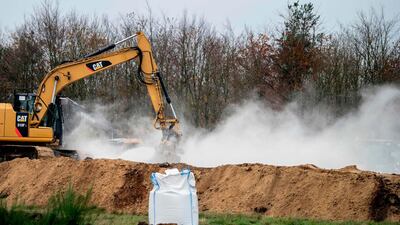The mink industry in Denmark, the world’s biggest producer, has effectively been wiped out after a mass slaughter of the animals to fight the coronavirus was rushed through.
“It’s a terrible and difficult situation, with the industry being shut down in a single blow,” said Tage Pedersen, the chairman of the Danish Fur Breeders’ Association.
“There’s no way back,” he said in an emailed comment. “Even if a few farmers somehow survive, there’s still no future. We can only survive if we have a large, robust business.”
Denmark is fighting a new mutation of the coronavirus found in its mink farms. Prime Minister Mette Frederiksen said the variant has the potential to derail efforts to develop a Covid vaccine. The only option left is to cull the country’s entire mink population of roughly 17 million animals, she said.
The Danish Fur Breeders’ Association estimated on Wednesday that about two-thirds of that population -- both infected and healthy animals -- have been culled. That’s after farmers acted on a government order which has since been retracted because it broke the law. Local media reported that all infected mink – roughly 8 million – would be dead by late Wednesday.
The fate of the animals, some of which were killed in such haste that there were eye-witness reports of thousands of mink carcasses strewn across a public motorway, provides a graphic reminder of the real-world consequences of a string of political missteps in Denmark that could have global consequences.
Ms Frederiksen’s handling of the crisis has drawn condemnation from a united parliament. Her government, which initially offered financial incentives to farmers to start culling as soon as possible, has since said it didn’t know the order to kill all Denmark’s mink required new legislation. An emergency bill needing a three-quarters majority has failed, and the legislative process is now in limbo.
Meanwhile, Denmark’s main animal rights group, Dyrenes Beskyttelse, said it plans to involve the police after viewing a video showing a botched cull by state workers.
The law states “that anyone who wants to put down an animal has to ensure that it’s done as painlessly as possible”, Yvonne Johansen, the head of Dyrenes Beskyttelse, said in a statement. “That’s not what I’m seeing here.”
Food and Fisheries Minister Mogens Jensen, who has overseen the planned eradication of Denmark’s mink, was grilled by lawmakers on Wednesday. He faced attacks from both the opposition and members of the ruling bloc, with some even calling for his resignation.
Ms Frederiksen’s government, which still expects a standard bill to pass with a simple majority of more than 50 per cent, wants all Danish mink farming to be banned until 2022. That means breeding animals will be wiped out, effectively shuttering the industry.
As Denmark gets dragged into a domestic political battle, scientists worry that the risk that mink mutations pose is misunderstood.
The arrival of Covid-19 in Denmark was a clear “game changer” for its mink farmers, Kare Molbak, the country’s top epidemiologist, told newspaper Politiken. Maintaining the industry now “represents far too high a national health risk”, he said.
“Mink are very easily infected by the coronavirus, and once it’s there, it spreads at the speed of light,” he said. “We’ve seen how that then spreads to humans. That makes it practically impossible to handle the spread during a pandemic.”

